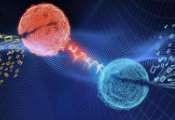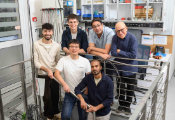Penn State’s Nitin Samarth Advances Quantum Materials Research at Q-NEXT
August 14, 2024 — As a researcher at Penn State, Nitin Samarth develops atomic states of matter for quantum technologies, catalogs their features and makes the data available to all.
It’s an important but unsung contribution to quantum technologies, which are expected to revolutionize areas such as finance and medicine in the coming decades. Headlines tout the potentially game-changing impact of quantum computers, but less media attention is paid to the atomic materials that lie at their foundation.
Scientists manipulate atomic states of matter in countless ways to create qubits — the fundamental units of quantum information. What features make these materials viable quantum-information carriers? How do you engineer them to bring out those features? Which properties are best suited to which uses?
A collaborator within Q-NEXT — a U.S. Department of Energy (DOE) National Quantum Information Science Research Center led by DOE’s Argonne National Laboratory — Samarth is a leader both in growing quantum materials and in building open libraries of quantum-materials data.
As part of Q-NEXT, Samarth is helping grow the capabilities of the Argonne Quantum Foundry, whose recent establishment was one of Q-NEXT’s achievements. An expert in creating different types of crystals for hosting qubits, Samarth advises other foundry researchers on promising avenues of exploration, advancing state-of-the-art quantum materials for real-world applications.
One material in particular has been of special interest to him and his Penn State group: boron-doped diamond. Diamond is a popular material for hosting qubits: It’s good at sustaining the qubit’s lifetime, and it’s easily incorporated into today’s information technologies.
The qubit itself takes the form of a nitrogen vacancy (NV) center: One of diamond’s carbon atoms is replaced by a nitrogen atom and an atom-sized hole. Using a laser, a scientist controls the NV center’s “spin” — a property of all atomic matter — to process quantum information. When boron is incorporated into the diamond in just the right way, scientists can systematically engineer the NV center’s behavior as a qubit.
Boron’s capabilities don’t stop there. Astonishingly, at high densities, boron can convert diamond from a nonconducting to a superconducting material. Samarth and the Q-NEXT team are excited about the prospects of boron-doped diamond for quantum technologies: Two foundational platforms for quantum information processing — superconducting devices and NV centers — could be integrated within a single material.
To realize the material’s potential, Samarth is pioneering the challenging process of controlling the placement of boron in thin films of diamond, mere micrometers thick, less than a tenth of the width of a human hair.
“The challenge has been understanding what we need to capture from a particular synthesis process and the easiest way to get all this information into a database,” Samarth said. “You want some way in which everything that we’re entering into the electronic lab notebook is easily sucked in by this database system without imposing extra burdens on the scientists running the synthesis tools. My colleagues in the 2DCC have done a superb job in developing such a framework!”
Q-NEXT will use some of the system’s database tools to track the structural properties, growth conditions and other technical aspects of materials synthesized at the Argonne Quantum Foundry.
And in a recent collaboration led by his Penn State colleague Cui-Zu Chang, scientists used the 2DCC facility to create superconducting material from two nonsuperconducting magnetic compounds. As an added bonus, these compounds can also be manipulated according to topological principles.
Together, Samarth’s work advances materials needed to build a viable quantum computer. “Who knows whether these materials will ever be important for quantum technology or not. There’s a lot more that has to be done before you can make them useful,” he said. “But it’s a good start. It’s always nice to have surprises.”
“The idea that one can use quantum technologies to really open up new ways to interrogate, to probe our universe, is fascinating,” Samarth said. “It’s going to be a while before society broadly benefits from quantum technologies, but the pace at which we are going over the last 10 years has completely amazed me.”




































